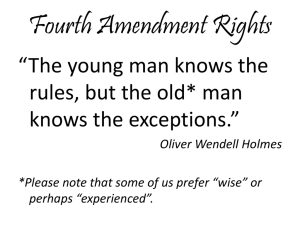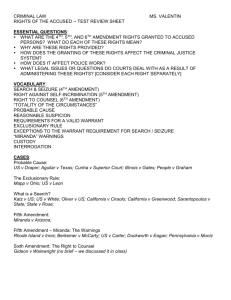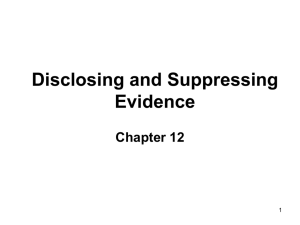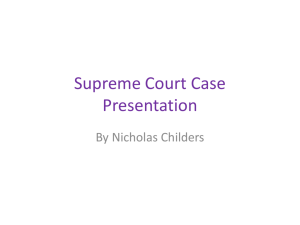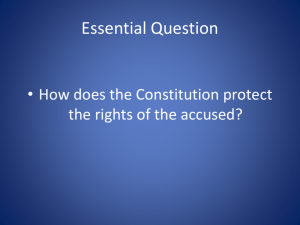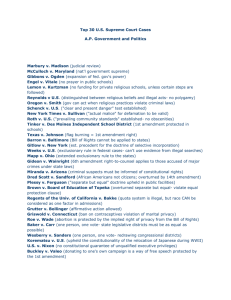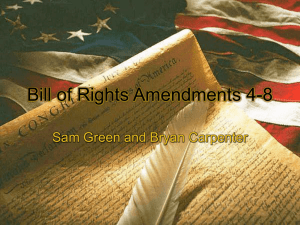Lesson - Rebel Rule
advertisement
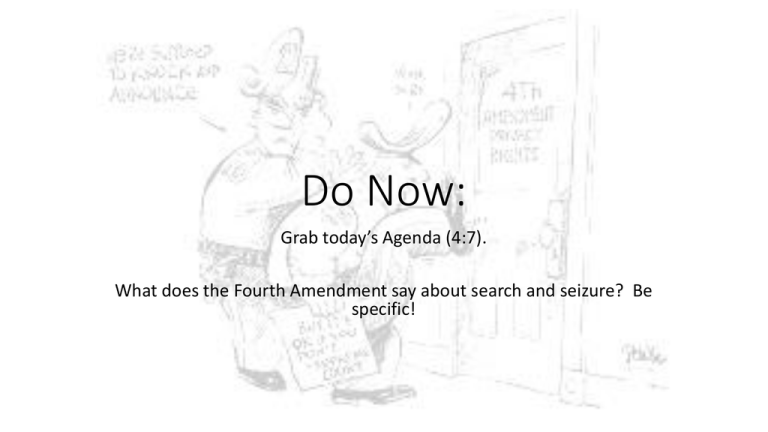
Do Now: Grab today’s Agenda (4:7). What does the Fourth Amendment say about search and seizure? Be specific! Search and Seizure • Historically • Reasonable Search and Seizure • Exclusionary Rule Historically Colonial America • In colonial America, the English rulers were not required to obtain search warrants targeted at specific individuals or locations. • Beginning in 1751, English soldiers and customs officers would write broad writs of assistance that would allow them to freely search for any sort of contraband. (The English imposed heavy taxes on colonists, and many American merchants resorted to smuggling to circumvent the tax laws.) • While the writs of assistance were intended to discourage or eliminate smuggling, it served to further alienate the colonists from the English government. Historically Fourth Amendment • The Framers of the Constitution, well aware of the American public’s fear of government tyranny, constructed the Fourth Amendment that guarantees protection for all citizens against unreasonable searches and seizures. • In addition, each state has adopted similar protections in their own Constitutions. • The due process clause of the 14th Amendment strengthens the Fourth Amendment and gives citizens even greater protection from illegal searches and seizures. Historically Protections • The Fourth Amendment protects citizens from unreasonable search and seizure. • It is difficult to define what constitutes a reasonable search or seizure, but the most important criterion is probable cause. • Probable cause requires police agencies to have reasonable suspicion that a person or place is involved in illegal activities. • Identifying probable cause gives police the authority to search and investigate suspicious persons or places, while still protecting the rights of citizens. • Police departments are not able to search a person or property based solely on an unfounded hunch or suspicion. Historically Protections • To further protect citizens against abuses, police are generally required to obtain a warrant prior to conducting a search or seizure in a home or business. • A warrant is a legal document, signed by a judge, authorizing authorities to conduct a lawful search or seizure. • A judge will only issue a warrant if the police are able to prove probable cause. • A warrant must identify a specific person or place that may be searched. It will also dictate exactly what the police are allowed to look for and the process they can follow when searching. Police must search in likely places and are prohibited from causing undue injury to occupants, other people, or the property itself. Reasonable Search and Seizure Katz v. United States (1967) - #1 • Yes. • The Court ruled that Katz was entitled to Fourth Amendment protection for his conversations and that a physical intrusion into the area he occupied was necessary to bring the Amendment into play. • “The Fourth Amendment protects people, not places.” Bottom Line: Reasonable Search and Seizure New Jersey v. T.L.O. (1985) - #2 • Yes and yes. • The Court had to balance the student’s expectation of privacy and the school’s interest in maintaining order and discipline. States have a duty to provide a safe school environment. Schools are required to have a “reasonable suspicion” to perform a search. • Her possession of any cigarettes was relevant to whether or not she was being truthful, and since she had been caught in the bathroom and taken directly to the office, it was reasonable to assume she had the cigarettes in her purse. • Thus, the vice-principal had reasonable cause to suspect a school rule had been broken, and more than just a “hunch” to search the purse. • When the vice-principal was searching for the cigarettes, the drug-related evidence was in plain view. Plain view is an exception to the warrant requirement of the Fourth Amendment. • Thus, the reasonable search for cigarettes led to some of the drug related material being discovered. Bottom Line: Reasonable Search and Seizure Vernonia School District v. Acton (1995) - #3 • No. • The reasonableness of a search is judged by “balancing the intrusion on the individual’s Fourth Amendment interests against the promotion of legitimate governmental interests.” • In the case of high school athletes who are under State supervision during school hours, they are subject to greater control than over free adults. • The privacy interests compromised by urine samples are negligible since the conditions of collection are similar to public restrooms, and the results are viewed only by limited authorities. • Furthermore, the governmental concern over the safety of minors under their supervision overrides the minimal, if any, intrusion in student-athletes’ privacy. Bottom Line: Reasonable Search and Seizure United States v. Jones (2012) - #4 • Yes. • The Court held that the installation of a GPS tracking device on Jones’ vehicle, without a warrant, constituted an unlawful search under the Fourth Amendment. • The Court rejected the government’s argument that there is no reasonable expectation of privacy in a person’s movement on public thoroughfares and emphasized that the Fourth Amendment provided some protection for trespass onto personal property. Bottom Line: Exclusionary Rule Problem • Although the Fourth Amendment protects citizens against unreasonable searches, it does not establish consequences if the police do not acquire a warrant prior to the search. • Furthermore, it does not implicitly prohibit law enforcement from gathering evidence that is not directly related to the warrant. Exclusionary Rule Weeks v. United States (1914) - #5 • Yes. • To allow private documents to be seized and then held as evidence against citizens would have meant that the protection of the Fourth Amendment declaring the right to be secure against such searches and seizures would be of no value whatsoever. • The Court established what eventually became known as the “exclusionary rule” – any evidence illegally obtained from the defendant cannot be used against the defendant. Bottom Line: Exclusionary Rule Silverthorne Lumber Co. v. United States (1920) - #6 • No. • To permit derivatives would encourage police to circumvent the fourth Amendment, so the illegal copied evidence was held tainted and inadmissible. • This precedent later became known as the “fruit of the poisonous tree doctrine” and is an extension of the exclusionary rule. Bottom Line: Exclusionary Rule Mapp v. Ohio (1961) - #7 • The Court brushed aside the First Amendment issue and declared that “all evidence obtained by searches and seizures in violation of the Constitution is, by the Fourth Amendment, inadmissible in a state court.” • Mapp had been convicted on the basis of illegally obtained evidence. • This was an historic – and controversial – decision. It placed the requirement of excluding illegally obtained evidence from court at all levels of the government. Bottom Line: Exclusionary Rule United States v. Leon (1984) - #8 • Yes. • The Court held that evidence seized on the basis of a mistakenly issued search warrant could be introduced at trial. • The exclusionary rule is not a right but a remedy justified by its ability to deter illegal police conduct. Bottom Line: Conclusion • Although well intentioned, the Fourth Amendment is vague and ambiguous. The Framers were explicit in their desire to protect the rights of citizens, but they did not provide a clear framework for what is considered “reasonable” search or seizure. • Police procedure revealed inconsistencies and raised many questions, but the Supreme Court did not play a major role in interpreting the Fourth Amendment until the late 20th century. • The exclusionary rule was established as a guideline for courts to determine the admissibility of evidence. The rule states that evidence that is not obtained within the scope of the Fourth Amendment cannot be used as evidence.
